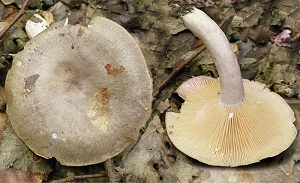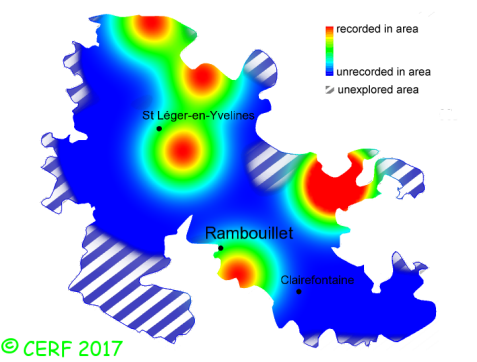| Lactarius circellatus Fr. |
|
|
|
|
|
|
The cap is pearl-grey to grey-brown, stained with pink or violet, slightly silvery when dry, convex-flattened, then shallowly depressed; its margin is smooth, inrolled at first. The cap surface is often with concentrical darker grey-brown bands, slightly greasy to the finger, sometimes slightly viscid in damp weather. The stem is white to grey (same colour as cap), sometimes washed with a lilac tinge and ochre-red towards its base, cylindrical to spindle-shaped, full then later hollow, without ring. The flesh is whitish, unchanging (or very slowly turning yellow or grey); its taste is mild at first, then hot-peppery and slightly bitter; the odour is pleasant, fruity; its texture is grainy (breaking like a chalk stick), exuding when cut a white milk, unchanging, or turning slowly to yellowish-green. The gills are white then cream-ochre to yellowish ochre with orange shades, adnate to slightly decurrent, close, narrow . The spore print is pale ochre, with a salmon tinge (D). This species is mycorrhizal. It grows on the ground, in deciduous woods, parks, gardens, always with hornbeams (sometimes hazel trees, but on high ground). The fruiting period takes place from July to November.
Chemical tests : milk not reacting to potash. Distinctive features : greyish cap, with lilac tones and concentrical darker grey-brown bands; close, ochre-yellow gills; abundant white milk, hot and (almost) unchanging; with hornbeams Lactarius circellatus is quite rare and localised in the forest of Rambouillet, and is occasional, more generally speaking . | ||
|
page updated on 14/01/18

